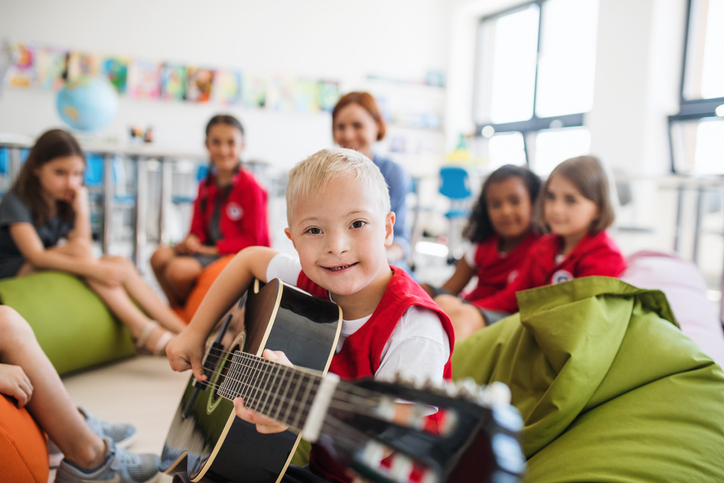
A new report by the National Academics of Sciences, Engineering, and Medicine suggests that public school districts should prioritize full-time, in-person classes for grades K-5 and for students with special needs.
Opening schools will benefit families beyond providing education, including by supplying child care, school services, meals, and other family supports. Without in-person instruction, schools risk children falling behind academically and exacerbating educational inequities.
Reopening K-12 Schools During the COVID-19 Pandemic: Prioritizing Health, Equity, and Communities recommends federal and state governments provide significant resources to districts and schools to help them cover the cost of COVID-19 precautions, including masks, enhanced cleaning, facility upgrades, and reconfigured classes.
While it will be impossible for schools to entirely eliminate the risk of COVID-19, the report says, young children in particular will be impacted by not having in-person learning and may suffer long-term academic consequences if they fall behind as a result. In grades K-3, children are still developing the skills to regulate their own behavior, emotions, and attention, and therefore struggle with distance learning. Schools should prioritize reopening for grades K-5 and for students with special needs who would be best served by in-person instruction.
“This pandemic has laid bare the deep, enduring inequities that afflict our country and our schools,” said Enriqueta Bond, chair of the committee that authored the report. “Many of the communities hardest hit by the virus are also home to schools with the least resources and the greatest challenges. Education leaders need to be careful when making the decision to reopen to not exacerbate these inequities.”
COVID-19 Precautions for Reopened Schools
The report also recommends schools and districts take the following precautions to protect staff and students:
- Provide surgical masks for all teachers and staff. All students and staff should wear face masks. Younger children may have difficulty using face masks, but schools should encourage compliance.
- Provide hand washing stations or hand sanitizer for all people who enter school buildings, minimize contact with shared surfaces, and increase regular surface cleaning.
- Limit large gatherings of students, such as during assemblies, in the cafeteria, and overcrowding at school entrances, possibly by staggering arrival times.
- Reorganize classrooms to enable physical distancing, such as by limiting class sizes or moving instruction to larger spaces. The report says cohorting, when a group of 10 students or less stay with the same staff as much as possible, is a promising strategy for physical distancing.
- Prioritize cleaning, ventilation, and air filtration, while recognizing that these alone will not sufficiently lower the risk of COVID-19 transmission.
- Create a culture of health and safety in every school, and enforce virus mitigation guidelines using positive approaches rather than by disciplining students.
The report says the cost of implementing these COVID-19 precautions will be very high, totaling approximately $1.8 million for a school district with eight school buildings and around 3,200 students. These costs are coming at a financially uncertain moment for many school districts, and could lead to funding shortfalls. While the size of the funding shortfall will depend on how well-resourced a school district is, many districts will be unable to afford implementing the entire suite of mitigation measures, potentially leaving students and staff in those districts at greater risk of infection.
Staffing Challenges
Staffing is likely to be a major challenge if and when schools reopen. A significant portion of school staff are in COVID-19 high-risk age groups, or are hesitant to return to work because of the health risks. The report says some COVID-19 mitigation strategies, such as maintaining smaller class sizes, will require additional teaching staff.
Deciding When to Reopen
When making the decision to reopen, education leaders should develop decision-making coalitions to allow for input from representatives of school staff, families, local health officials, and other community interests. These coalitions should decide educational priorities for reopening schools; be explicit about financial, staffing, and facility constraints; and establish an ongoing plan for communicating about school decisions and resources. In developing reopening plans, districts should also take existing educational disparities into account, such as school facilities, staffing, and overcrowding, as well as disparities among students and families. Schools should partner closely with public health officials to assess school facilities for minimum health standards and consult on school plans for COVID-19 mitigation.
Continued School Monitoring During COVID-19
The decision to reopen schools should be iterative, and schools should be prepared for future school closures based on the progress of the pandemic. The report recommends public health officials develop a protocol for monitoring COVID-19 data to make decisions about changes to school virus mitigation strategies, and make judgments about future school closures in partnership with school districts. States should ensure that districts have access to ongoing support from public health officials.
Unanswered Questions and Continued Research
The report recommends research be conducted immediately to investigate the link between children and the transmission of COVID-19, the role of reopening schools in community spread, airborne transmission of the virus, and the effectiveness of various virus mitigation strategies. The evidence needed to make informed decisions about school reopening and safe operation is lacking in many areas, and further research is required.
The study — undertaken by the Committee on Guidance for K-12 Schools on COVID-19 — was sponsored by the Spencer Foundation and the Brady Education Foundation and completed in collaboration with the National Academies Standing Committee on Emerging Infectious Diseases and 21st Century Health Threats.
The National Academies of Sciences, Engineering, and Medicine are private, nonprofit institutions that provide independent, objective analysis and advice to the nation to solve complex problems and inform public policy decisions related to science, technology, and medicine. They operate under an 1863 congressional charter to the National Academy of Sciences, signed by President Lincoln.





